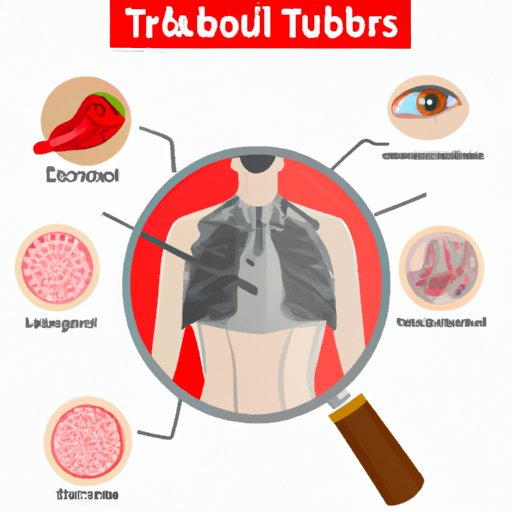
Introduction
Tuberculosis, or TB, is an infectious disease that primarily affects the lungs. It’s caused by bacteria and can be life-threatening if left untreated. Recognizing the symptoms of TB is important for early diagnosis and treatment. In this article, we will provide an overview of the various symptoms associated with TB and explain why it’s critical to seek medical attention as soon as possible if you experience any of these symptoms.
Don’t Ignore These Tuberculosis Symptoms: Recognizing the Signs of an Infectious Disease
The most common symptoms of TB include coughing, chest pain, and fatigue. Other symptoms include fever, night sweats, and a loss of appetite. Coughing can last for weeks, and it may produce blood or mucus.
Chest pain and shortness of breath are also common symptoms of TB. The chest pain may get worse when breathing or coughing. Fatigue is a general feeling of tiredness and weakness. Fever is when the body’s temperature is higher than usual. Night sweats, which are often severe, can cause you to wake up drenched in sweat. A loss of appetite can lead to unintended weight loss.
If you experience any of these symptoms, it’s important to consult a doctor as soon as possible. TB is a serious disease that, if not treated, can lead to severe health complications and even death.
Understanding Tuberculosis: A Guide to Identifying Symptoms and Seeking Treatment
TB is spread when an infected person coughs or sneezes. The bacteria become airborne and can be breathed in by people nearby. It’s important to note that not everyone who contracts TB will develop symptoms. In those cases, the disease is known as latent TB.
When TB affects the body, it usually invades the lungs. From there, it can spread to other areas such as the brain, spine, or kidneys. TB is diagnosed through a series of tests, such as a chest X-ray or a skin test. Depending on the severity of the infection, treatment can involve taking antibiotics for several months.
Early diagnosis and treatment are critical in preventing the spread of TB and minimizing its impact on your health. If you suspect you have TB, it is important to seek medical attention right away.
From Coughs to Chills: An In-Depth Look at the Spectrum of Tuberculosis Symptoms
TB can affect different parts of the body in different ways. When it affects the lungs, it can cause coughing, chest pain, and shortness of breath. In some cases, TB can cause a cough that lasts for months.
In addition to respiratory symptoms, TB may cause other symptoms such as fever, chills, night sweats, loss of appetite, and unintended weight loss. If the disease spreads to the brain, it can cause headaches, confusion, and seizures. When TB affects the spine, it can cause back pain and muscle weakness. When TB affects the kidneys, it can cause painful urination and blood in the urine.
TB’s range of symptoms can make it difficult to identify, which is why it’s important to pay attention to any unusual or persistent symptoms that may indicate the presence of the disease. If you suspect you or someone you know has TB, seek medical attention immediately.
The Tell-Tale Signs of Tuberculosis: How to Spot the Disease and Protect Your Health
There are several steps you can take to protect yourself and others from TB. The first is to avoid spending extended periods of time in close proximity to someone who has TB. If you do have close contact with someone who has TB, wear a mask to reduce your risk of infection.
Another important step is to practice good hygiene, such as washing your hands frequently and covering your mouth when coughing or sneezing. If you suspect you have TB, seek medical attention right away. And if you suspect someone else has TB, encourage them to seek medical attention as well.
Early diagnosis and treatment is key in preventing the spread of TB and protecting your health and the health of those around you.
Unraveling the Mystery of Tuberculosis Symptoms: A Comprehensive Overview for Patients and Caregivers
If you have been diagnosed with TB, it’s important to follow your doctor’s instructions carefully. Treatment for TB typically involves taking antibiotics for several months. It’s important to complete the full course of treatment even if you start to feel better before the medication is finished.
You may also need to take steps to prevent the spread of TB, such as wearing a mask and avoiding close contact with others until you are no longer contagious. Eating a healthy diet and getting plenty of rest can help support your immune system and speed up the healing process.
If you are a caregiver for someone with TB, it’s important to take steps to protect yourself from infection. This includes wearing a mask, washing your hands frequently, and practicing good hygiene. You should also encourage the person with TB to follow their treatment plan and attend all necessary medical appointments.
Conclusion
Tuberculosis is a serious disease that can be life-threatening if left untreated. It’s important to recognize the symptoms of TB and seek medical attention right away if you suspect you have the disease. By understanding the symptoms, taking steps to protect yourself and others, and following your doctor’s instructions carefully, you can successfully manage TB and minimize its impact on your health.





